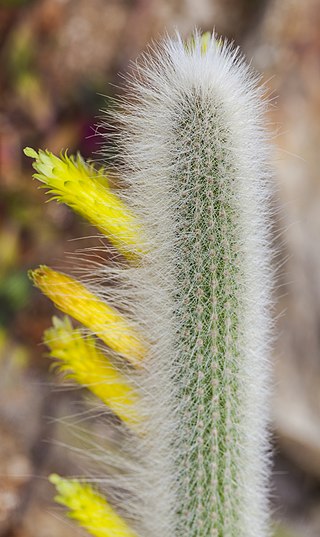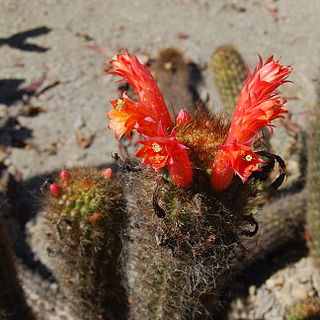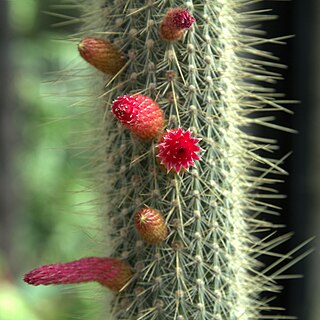
Cleistocactus strausii, the silver torch or wooly torch, is a perennial flowering plant in the family Cactaceae. It is native to mountainous regions of Department Tarija, Bolivia, at 1,500–3,000 m (4,921–9,843 ft).

Stetsonia coryne, the toothpick cactus, is the sole species in the cactus genus Stetsonia. Stetsonia coryne grows to a height of 15 to 25 ft tall. It has white flowers.

Cleistocactus winteri is a succulent of the family Cactaceae. Its common name is the golden rat tail. Cleistocactus winteri subsp. colademono, as its synonym Cleistocactus colademononis, has gained the Royal Horticultural Society's Award of Garden Merit.

Cleistocactus hyalacanthus is a species of columnar cacti in the genus Cleistocactus. The name comes from the Greek kleistos meaning closed because the flowers hardly open.

Oreocereus celsianus, or the old man of the mountain is a member of the family Cactaceae native to the high lands of the Andes in South America, and is named for its fluffy white hair, which may protect it from intense sunlight and extreme temperatures.

Cleistocactus morawetzianus is a species of columnar cactus in the genus Cleistocactus, endemic to Peru.

Cleistocactus tominensis is a species of columnar cactus in the genus Cleistocactus, endemic to Bolivia, where it is found in forests, on cliffs, and in inter-Andean valleys at altitudes of 900 to 2,200 meters.

Gymnocalycium bruchii is a species of Gymnocalycium from Argentina.

Cereus phatnospermus, synonym Cereus kroenleinii, is a species of columnar cactus found in Brazil, Bolivia, and Paraguay.

Cereus stenogonus, also known as narrow-angled cereus, is a species of Cereus found in Bolivia, Paraguay and Argentina.

Acanthocalycium rhodotrichum is a species of Acanthocalycium found in Argentina, Bolivia, Brazil, Paraguay, and Uruguay

Cleistocactus ritteri is a species of Cleistocactus found in Bolivia.

Cleistocactus smaragdiflorus is a species of Cleistocactus found in Bolivia and Argentina.

Cleistocactus candelilla is a species of Cleistocactus found in Bolivia.

Cereus fernambucensis is a species of Cereus found in Brazil.

Loxanthocereus acanthurus is a species of Loxanthocereus found in Peru.

Cleistocactus brookeae is a species of columnar cacti in the genus Cleistocactus.

Cleistocactus buchtienii is a species of columnar cacti in the genus Cleistocactus.

Cleistocactus parviflorus is a species of columnar cacti in the genus Cleistocactus.

Coryphantha erecta is a species of Coryphantha found in Mexico.



























